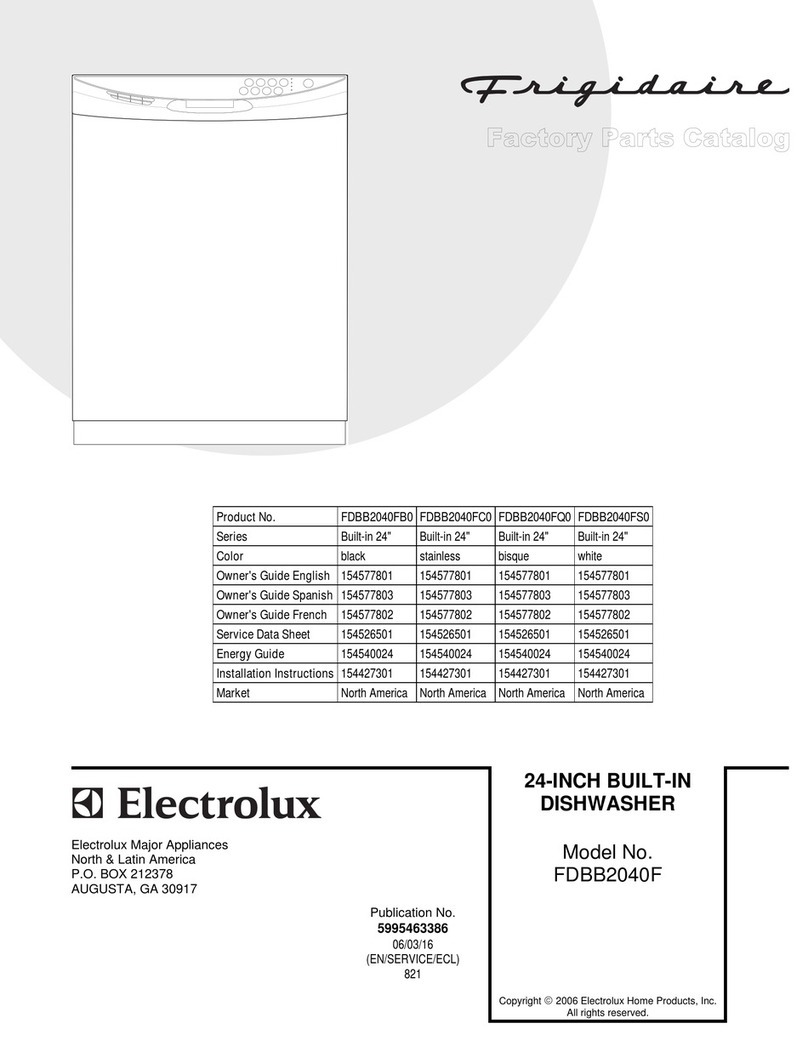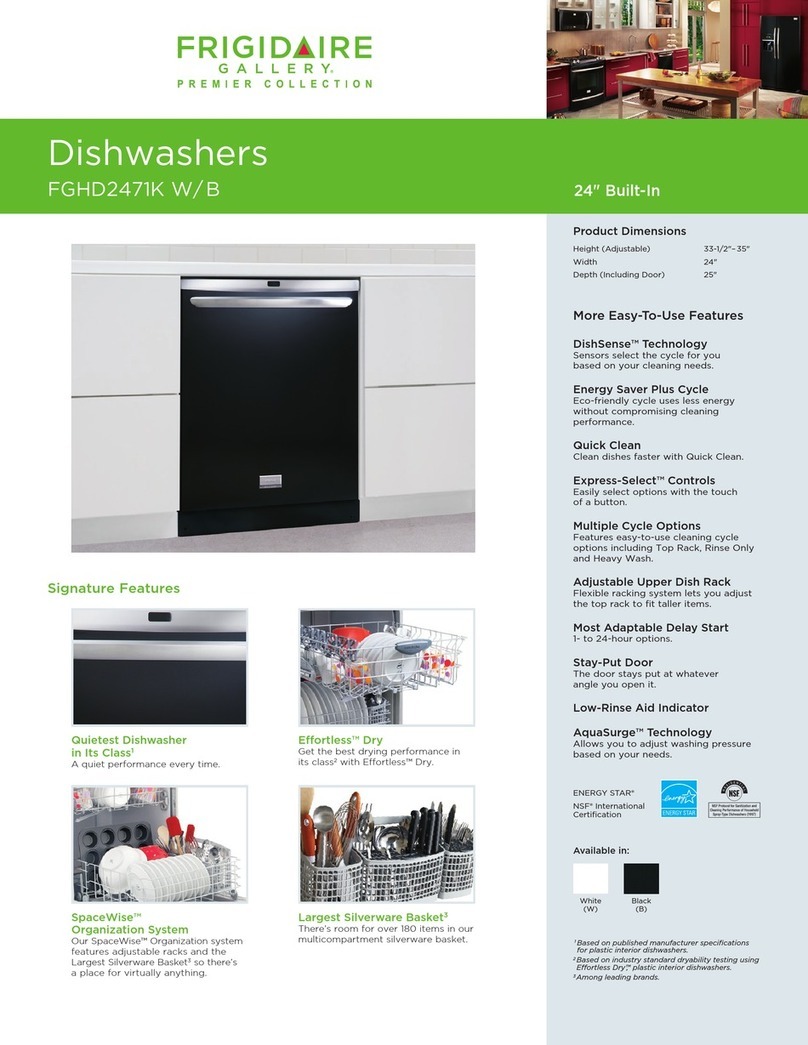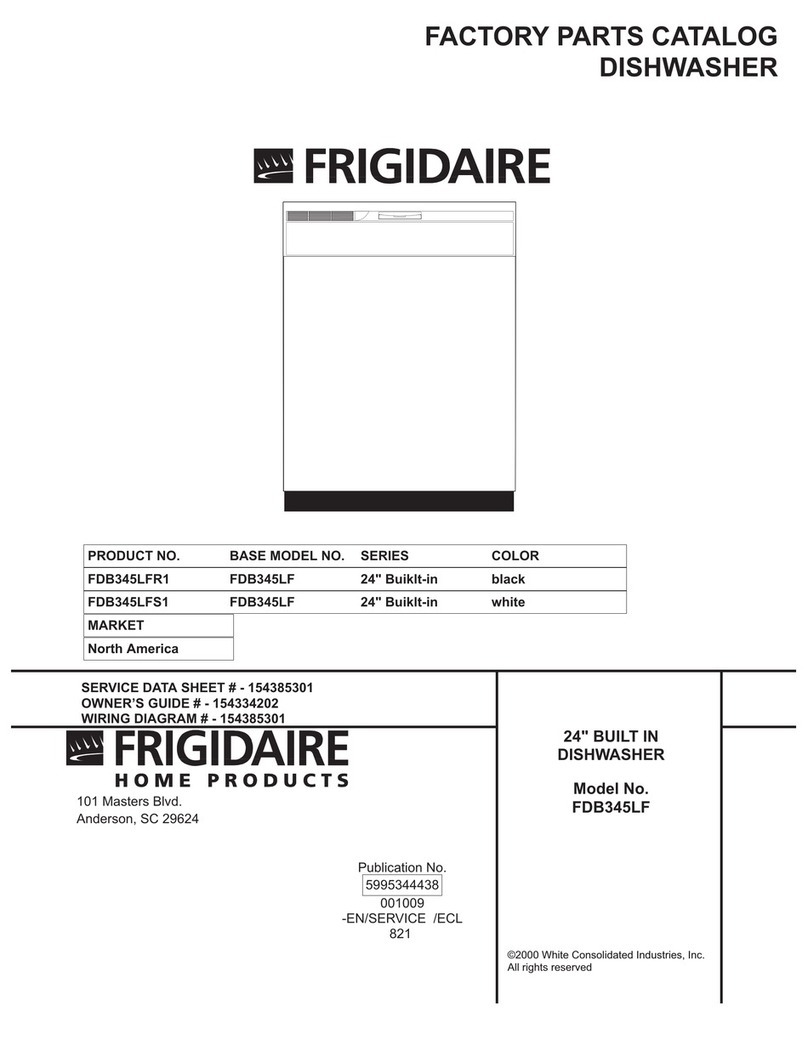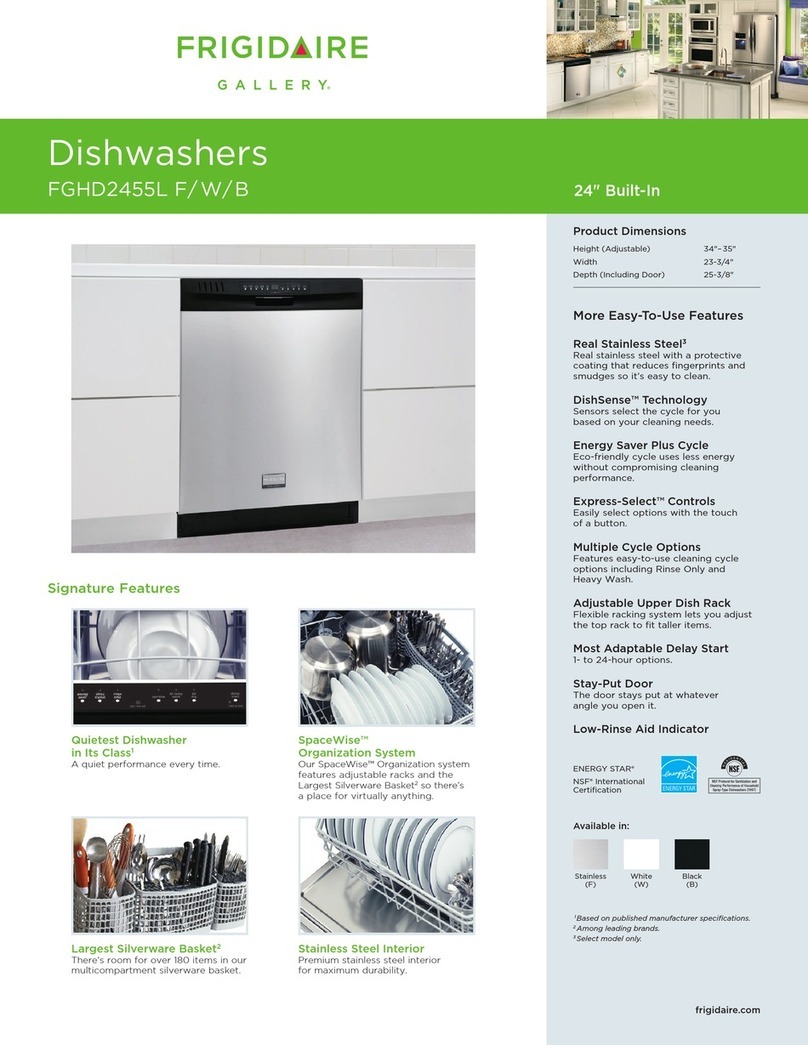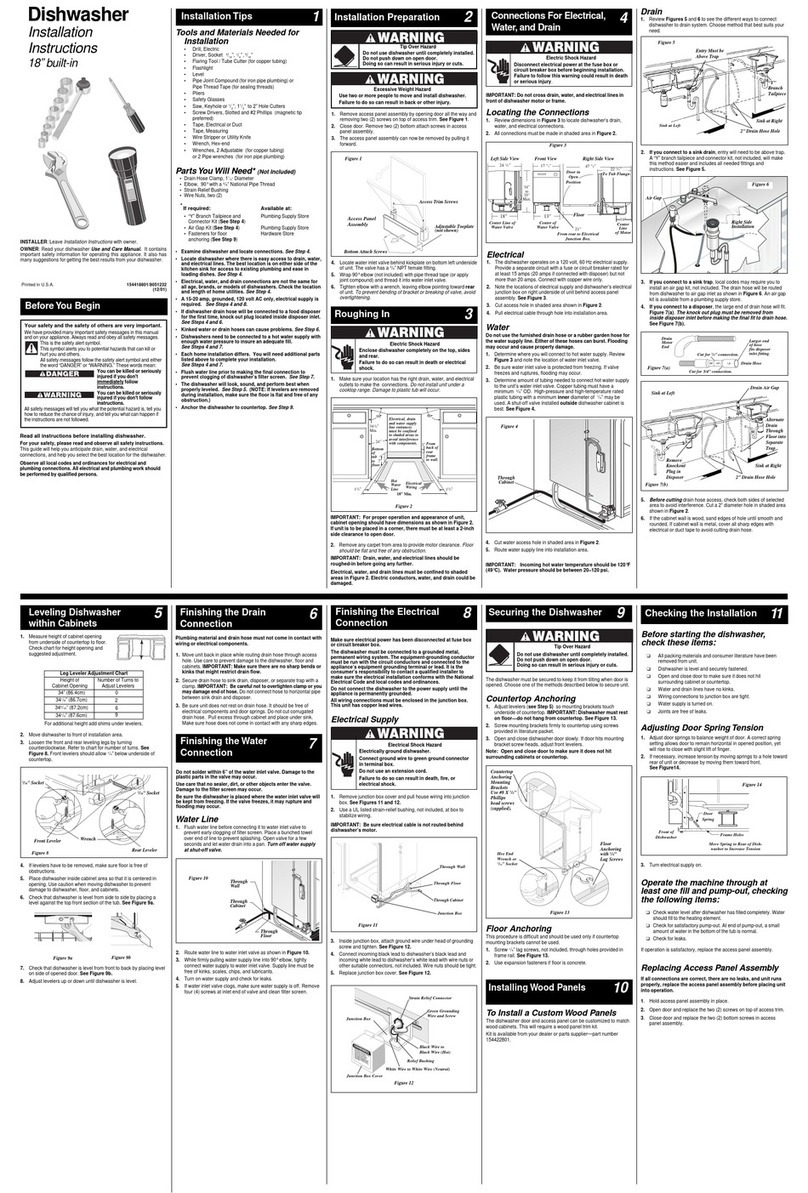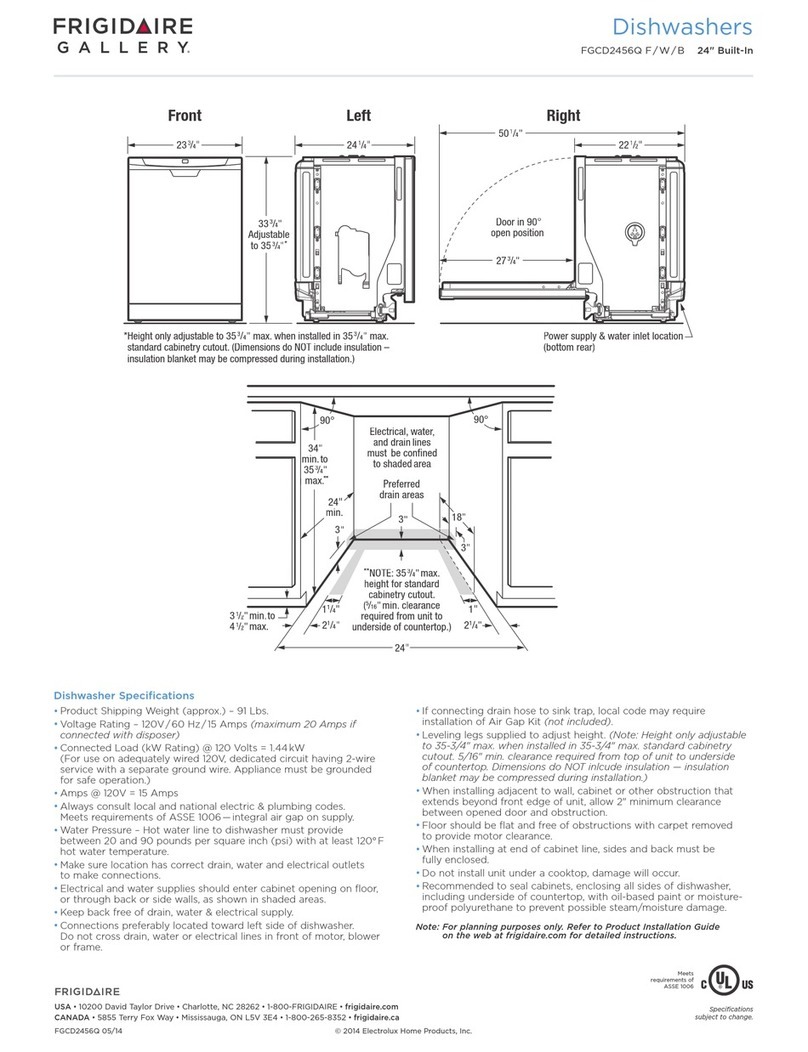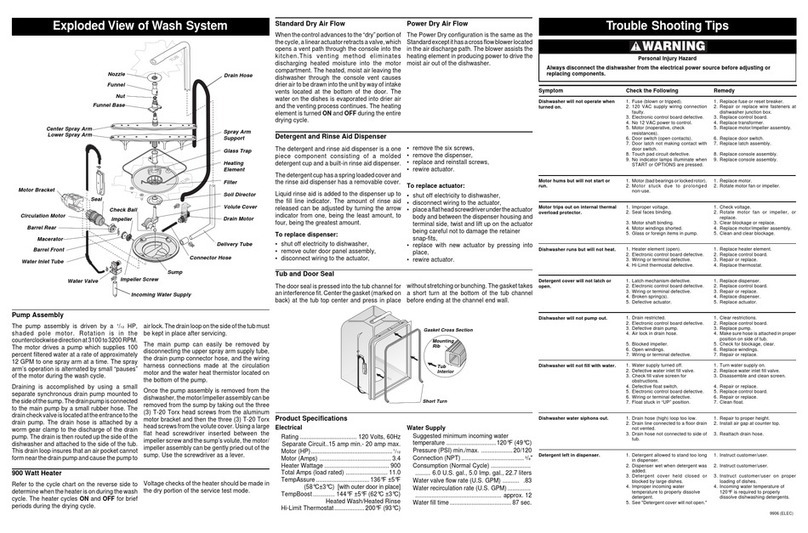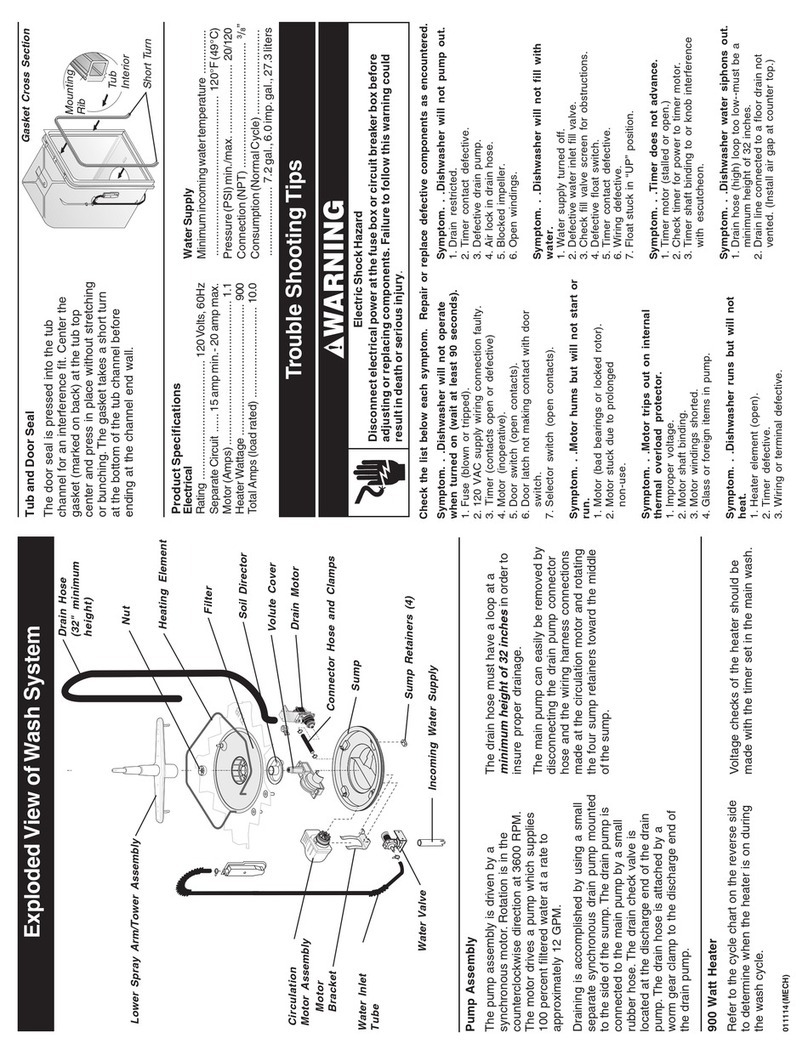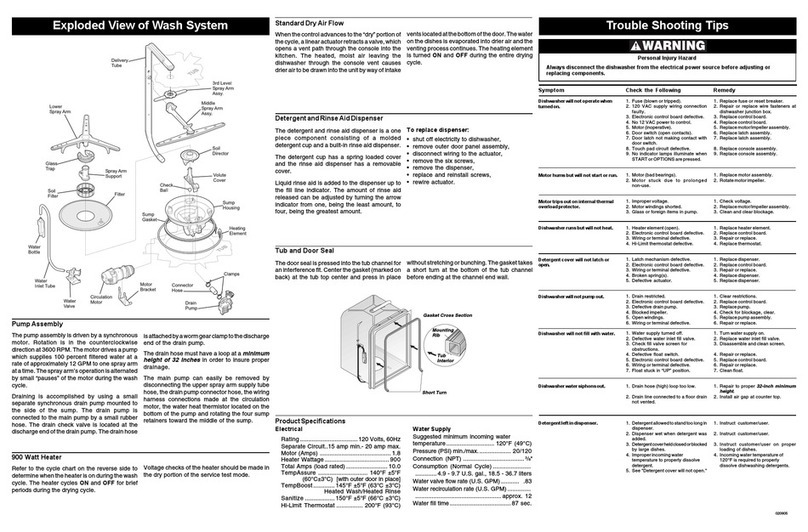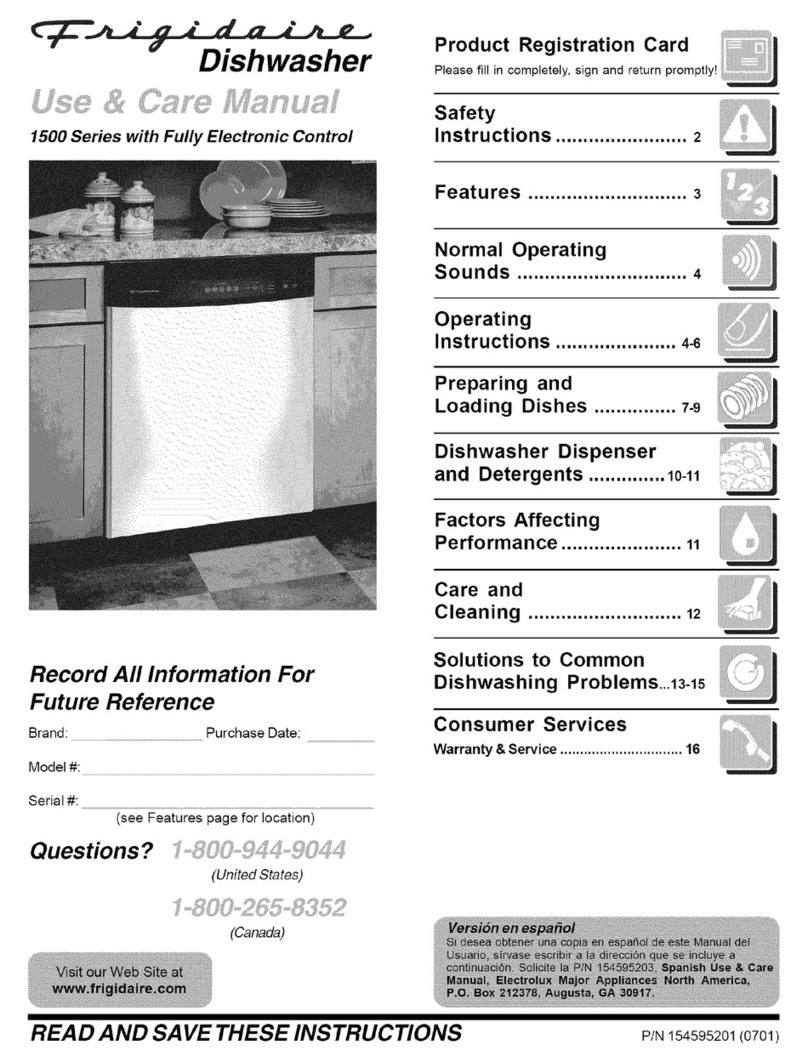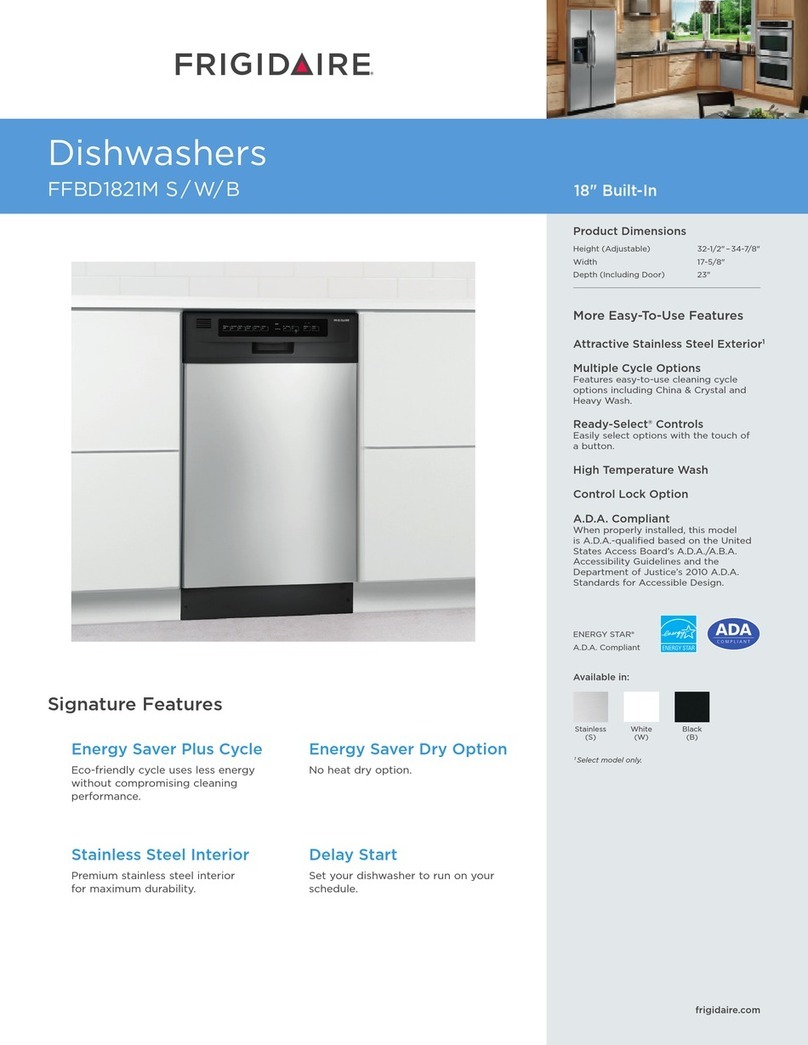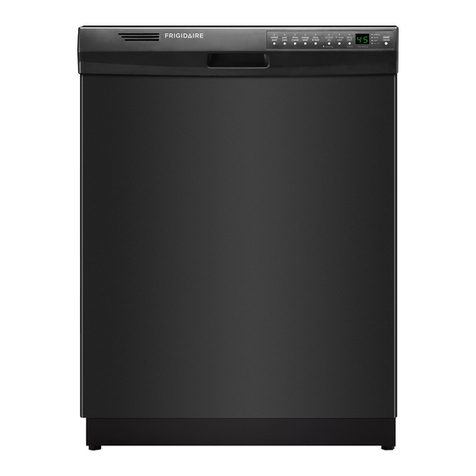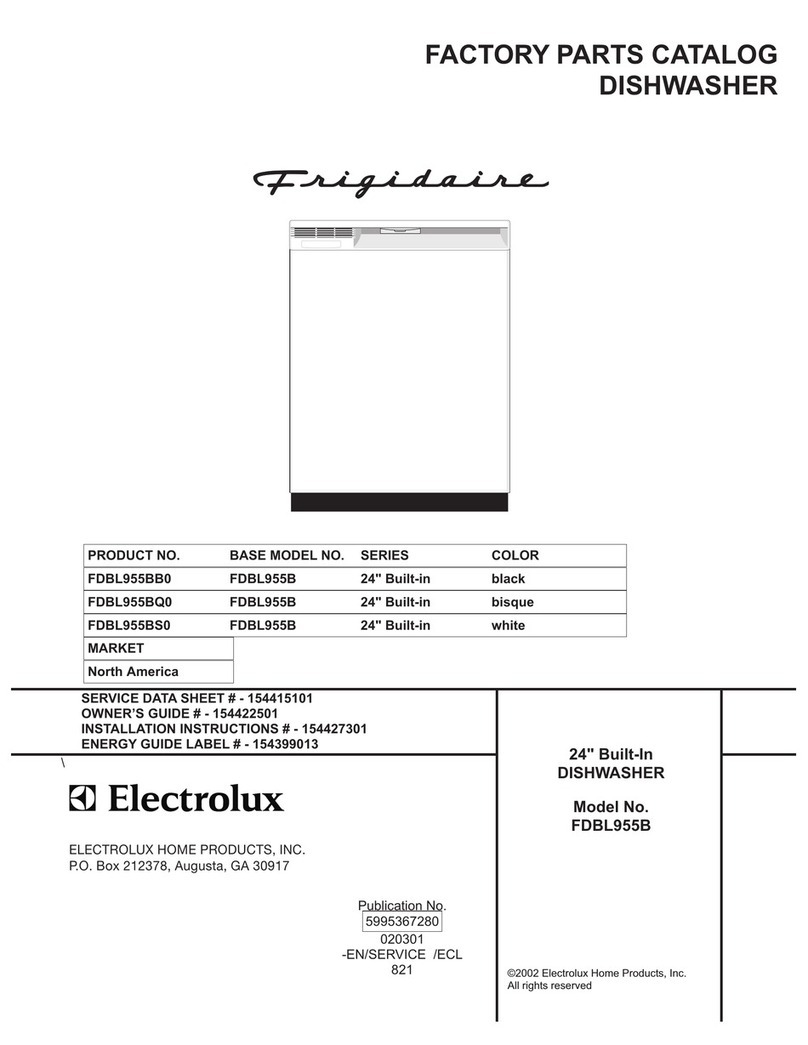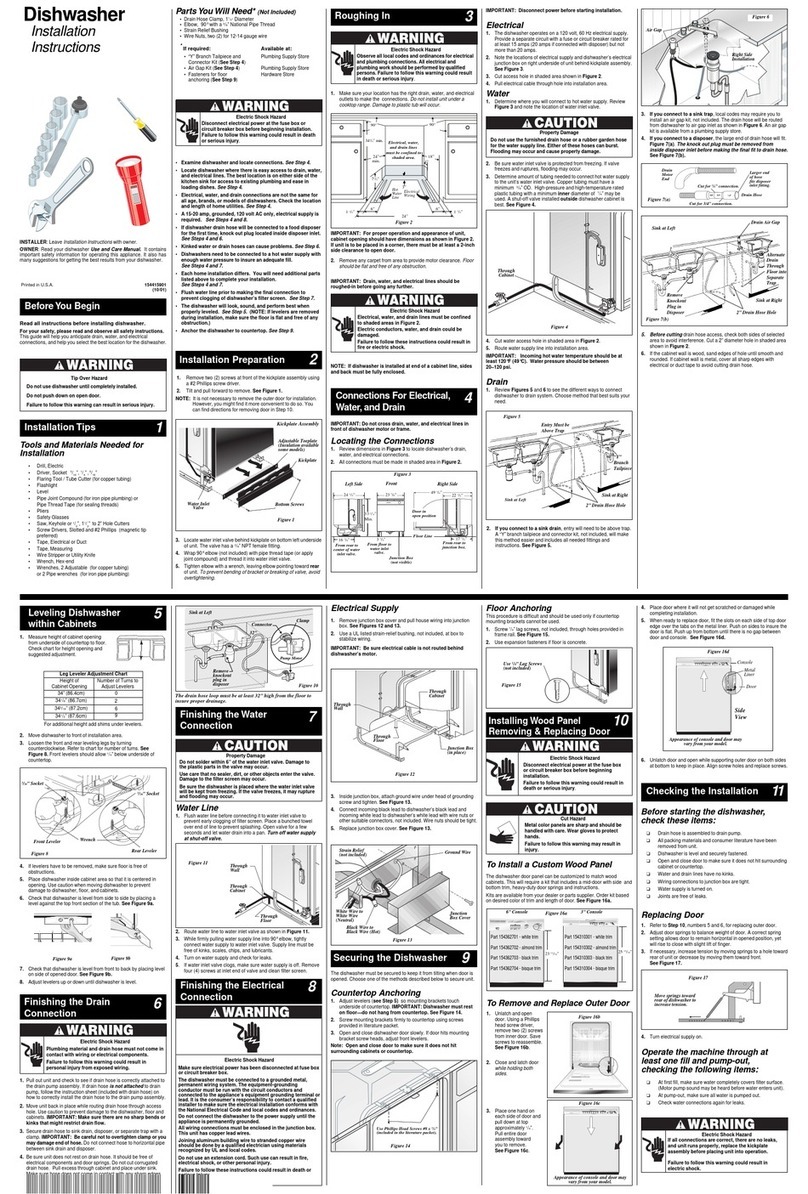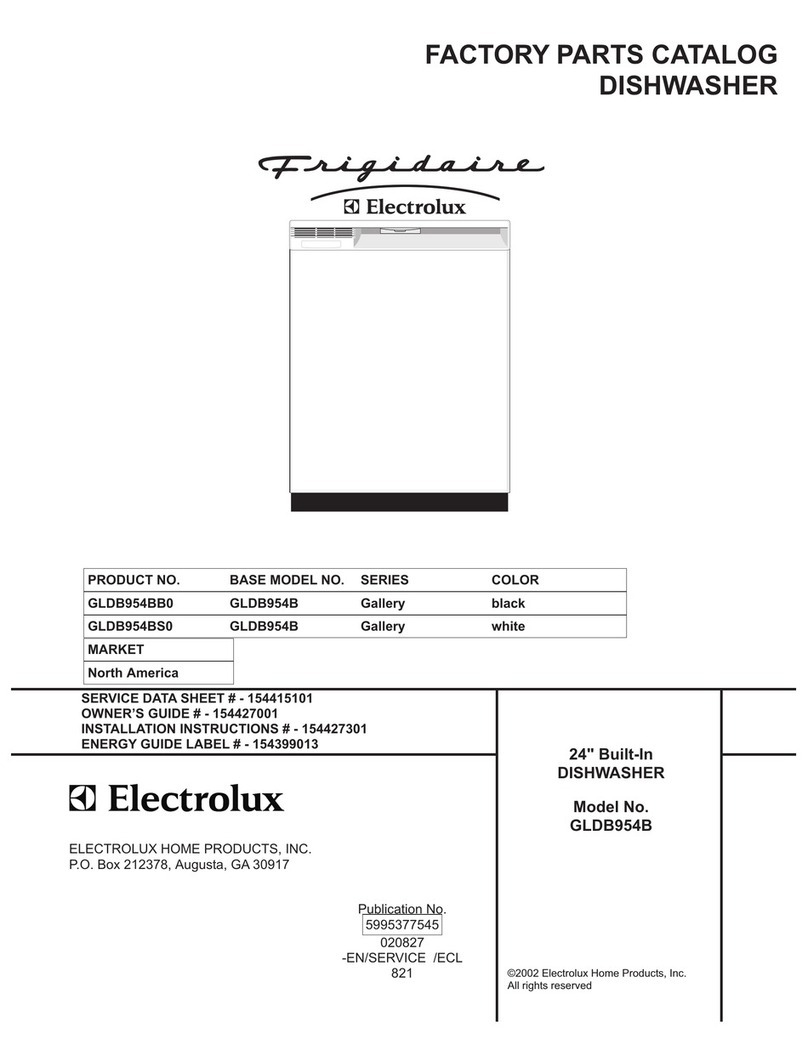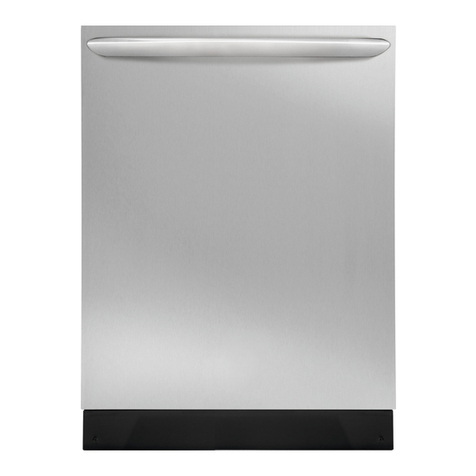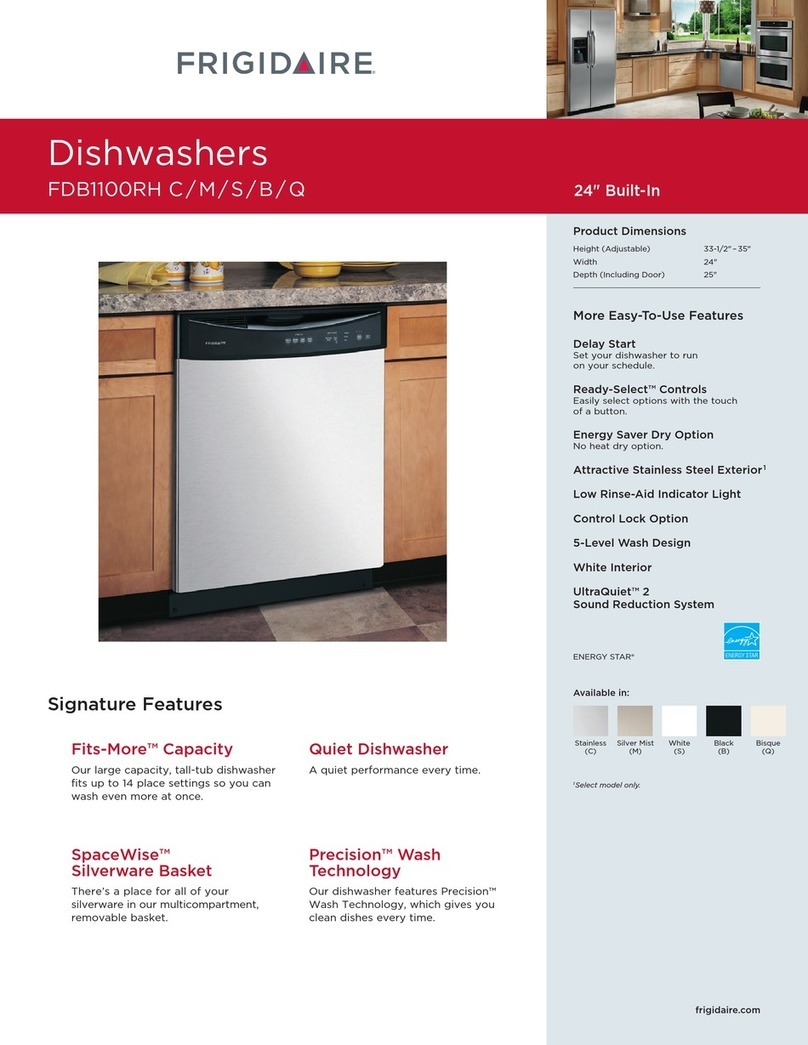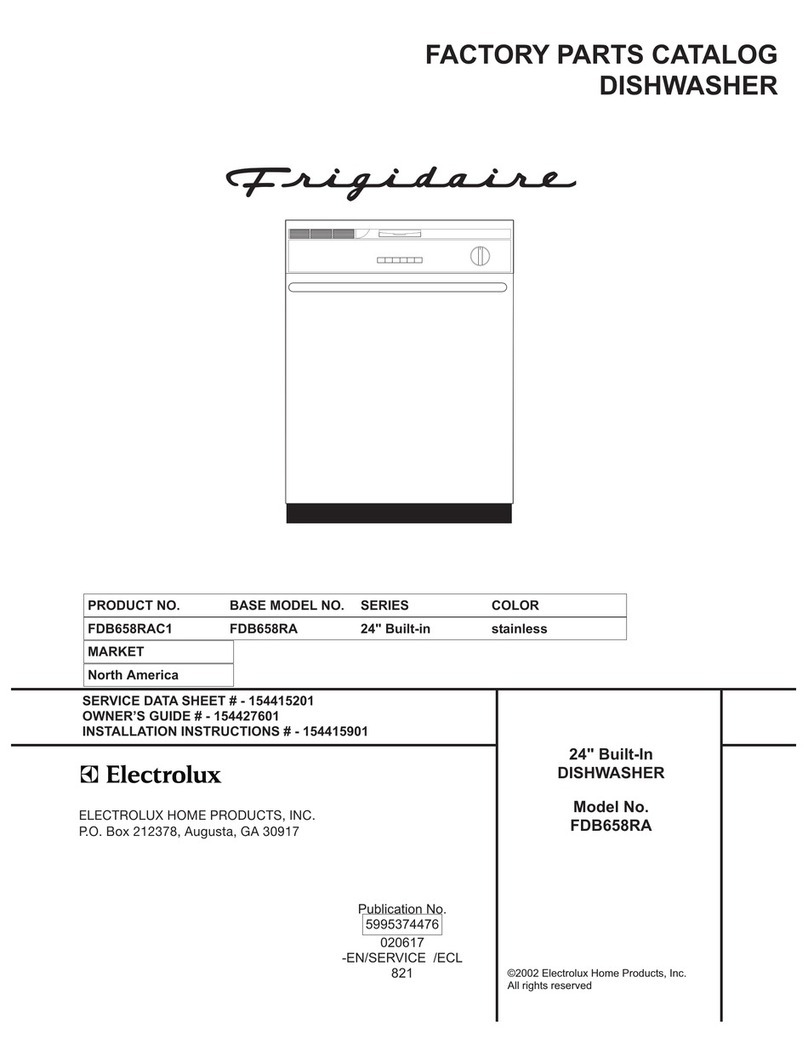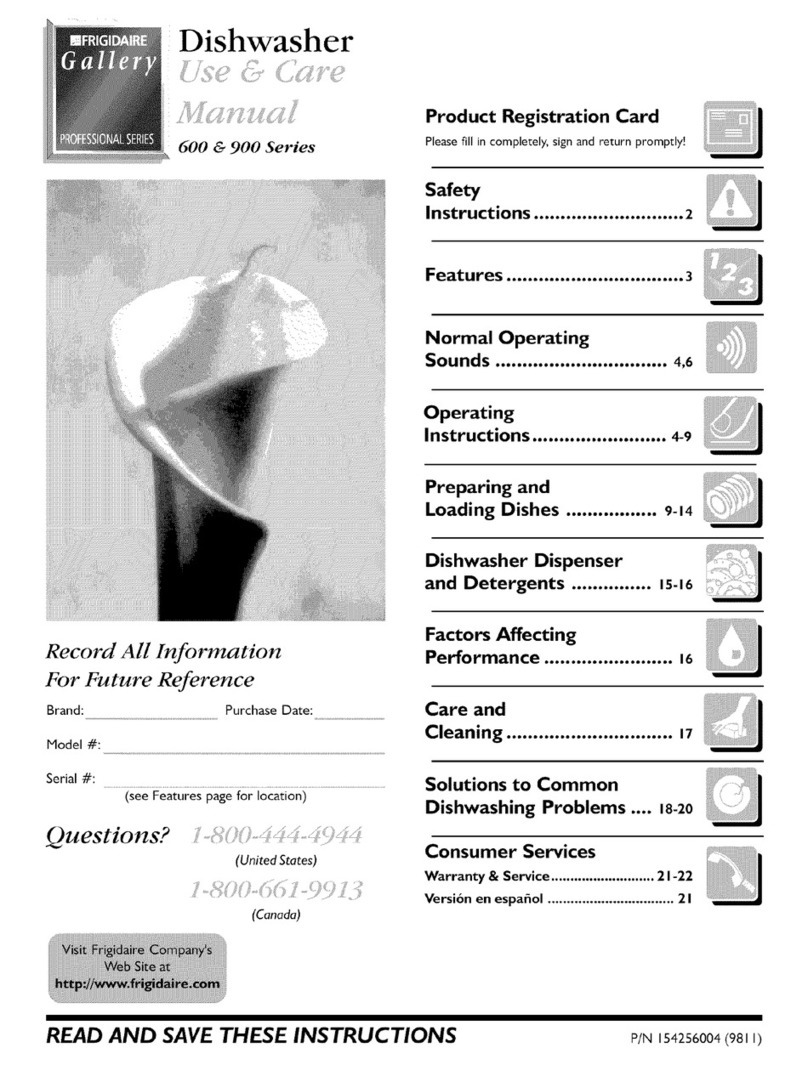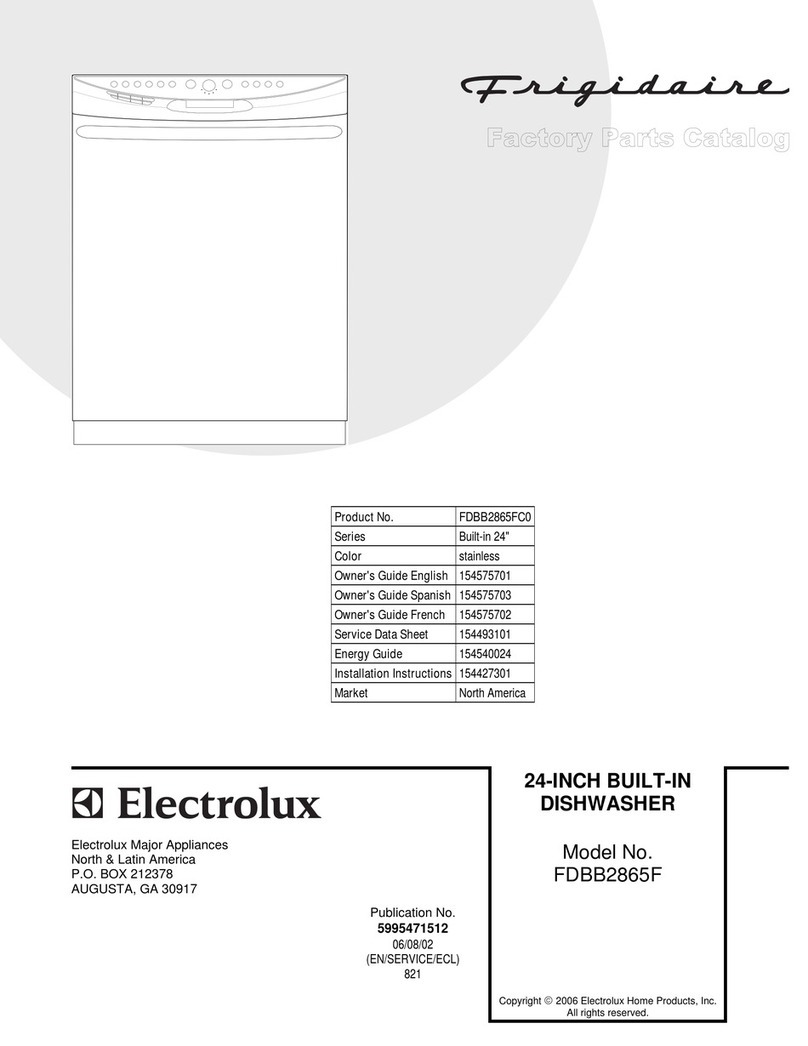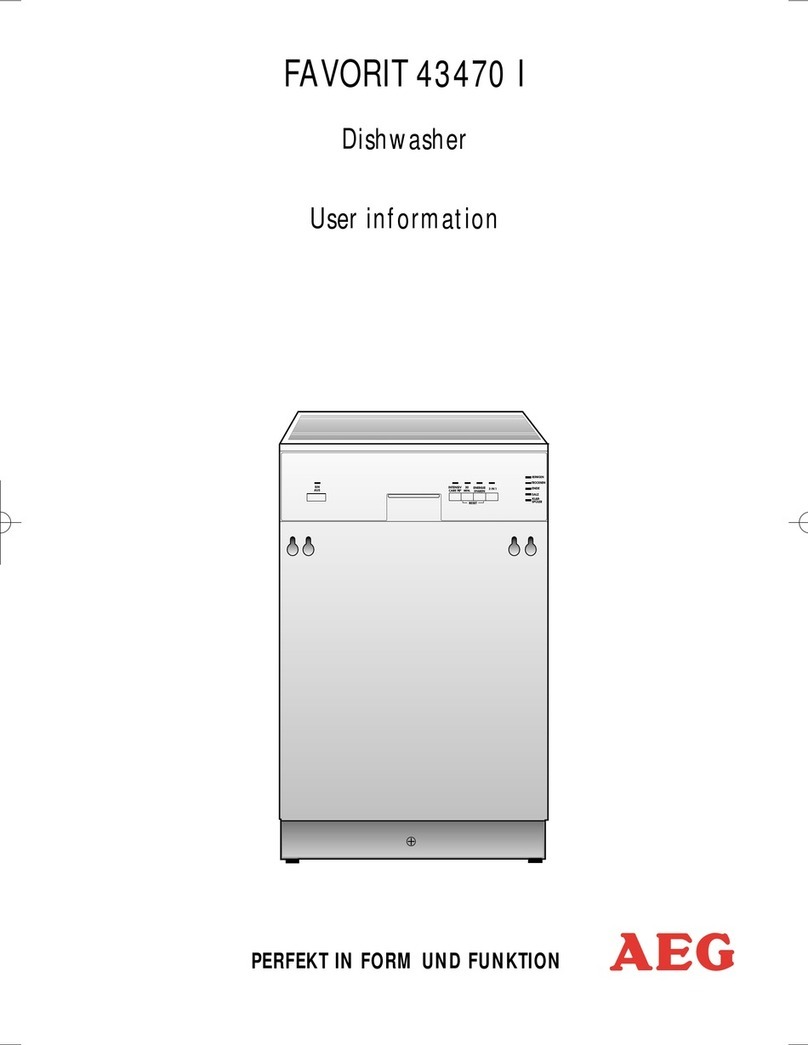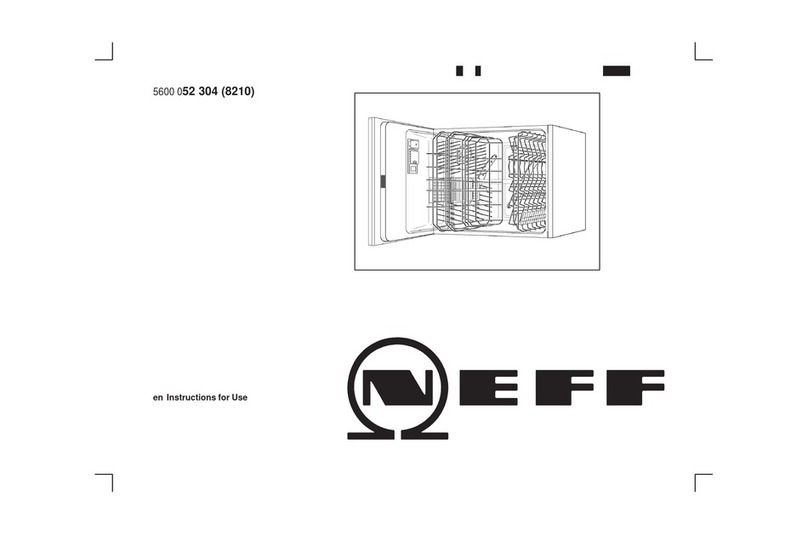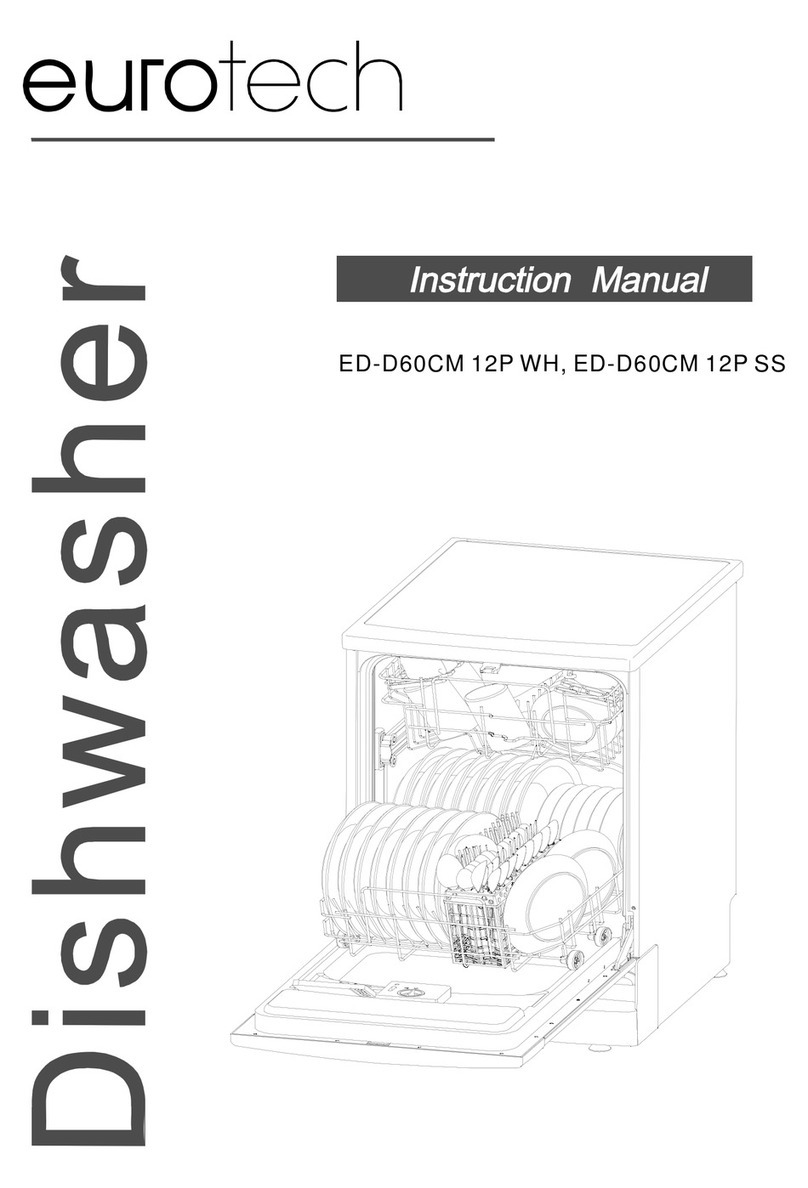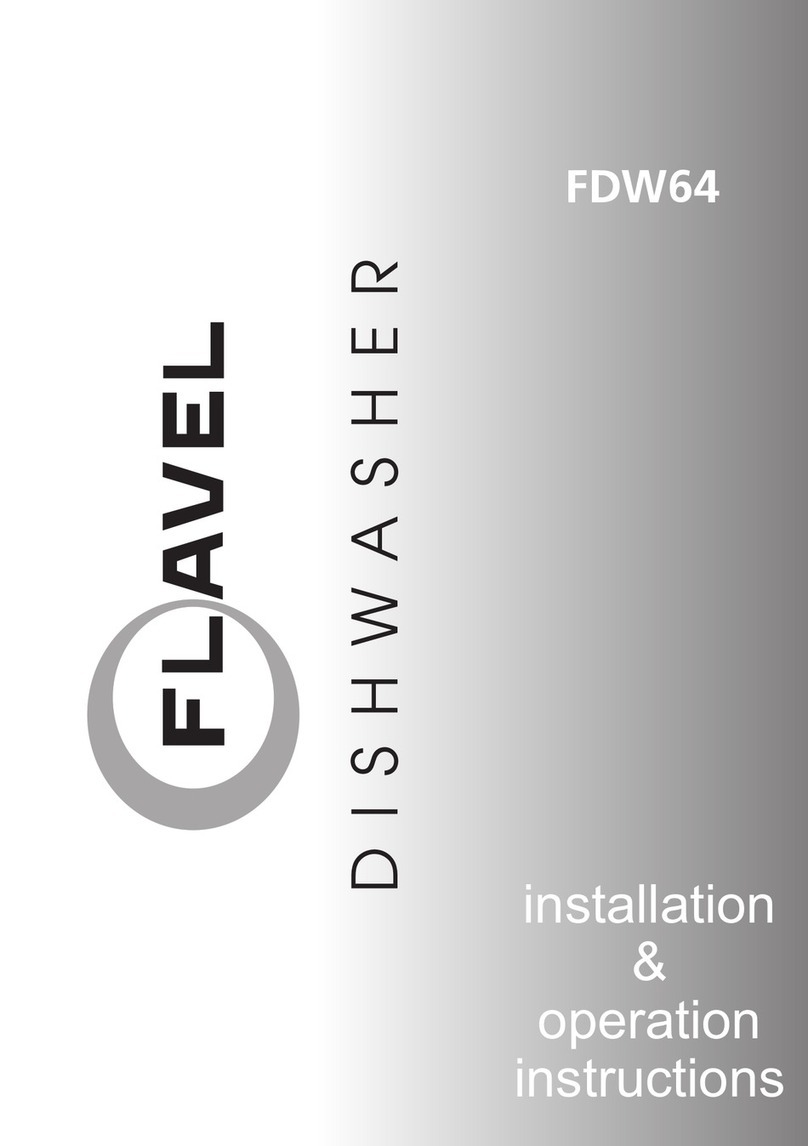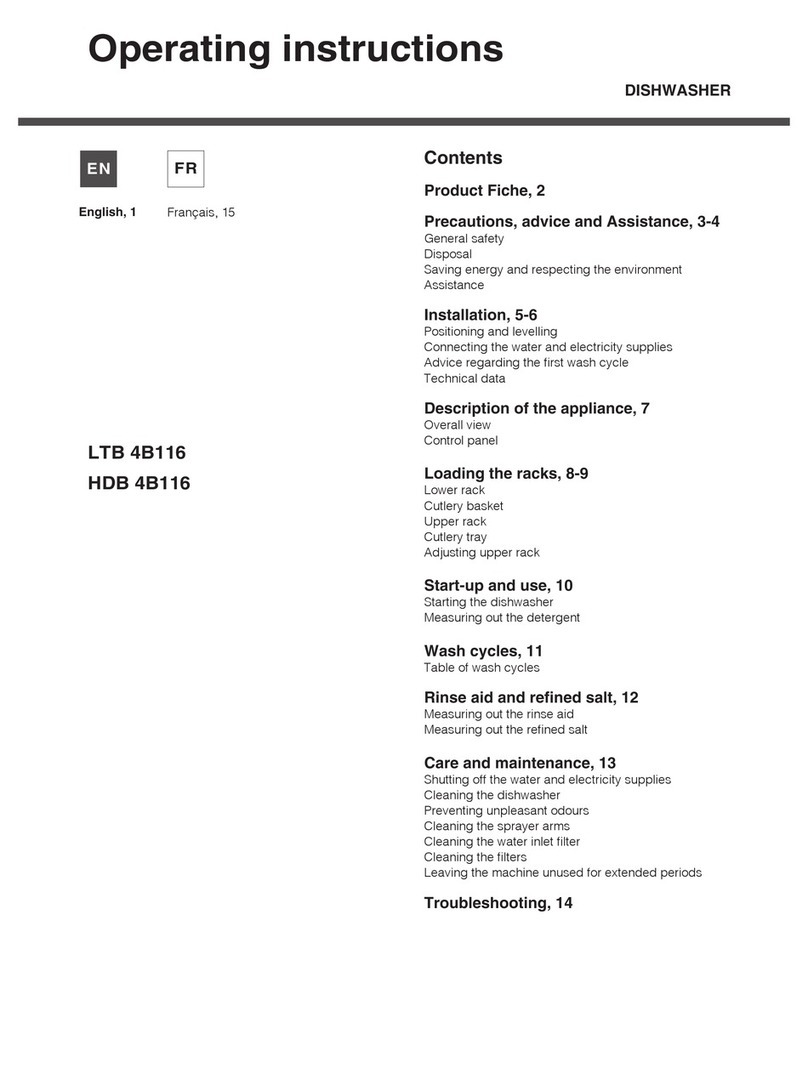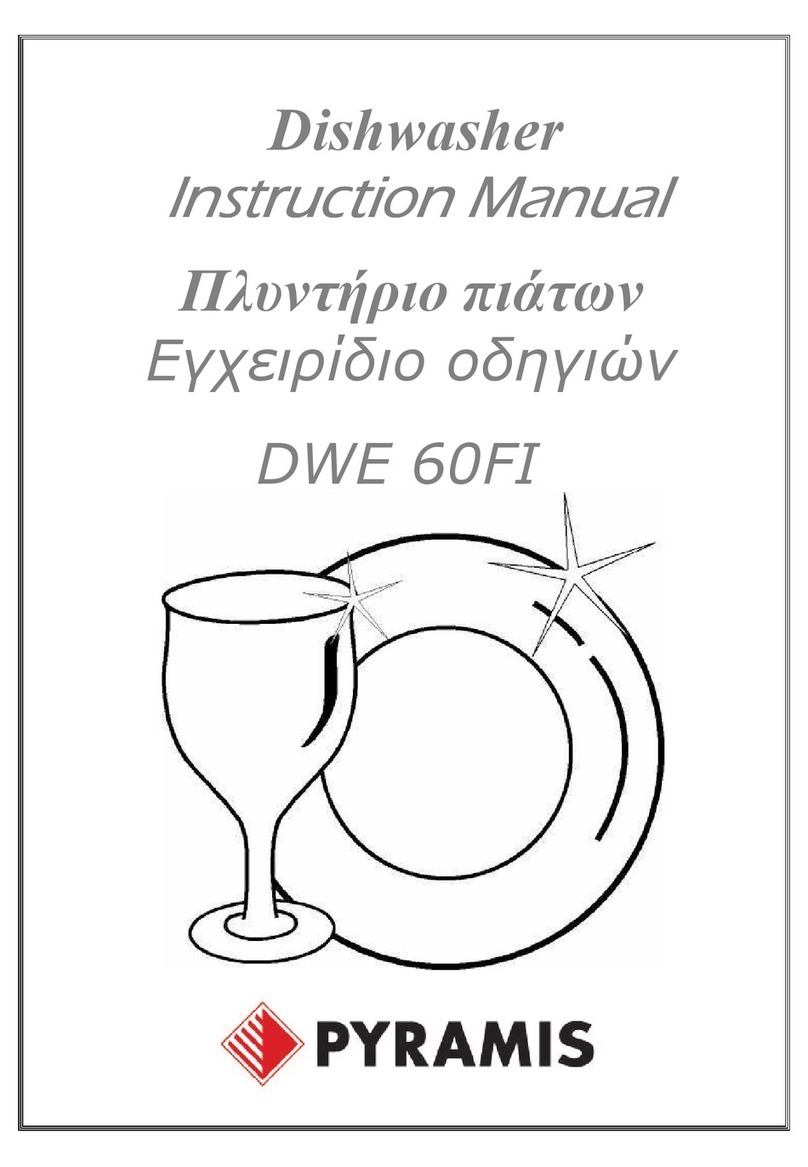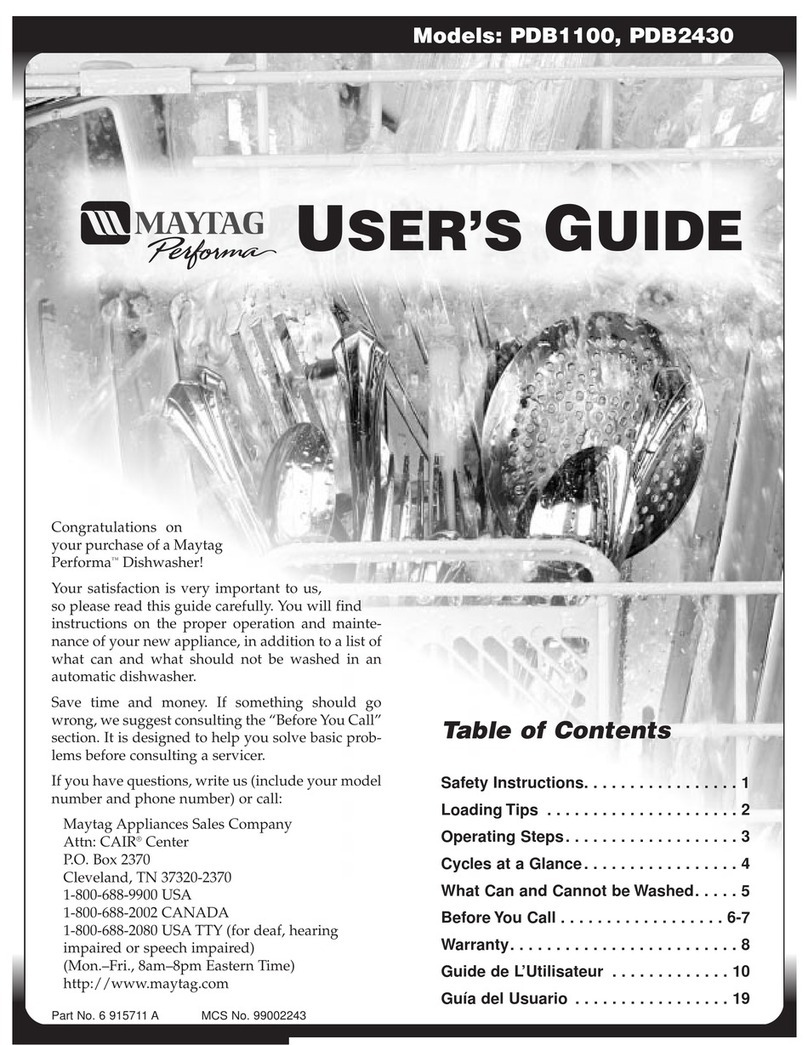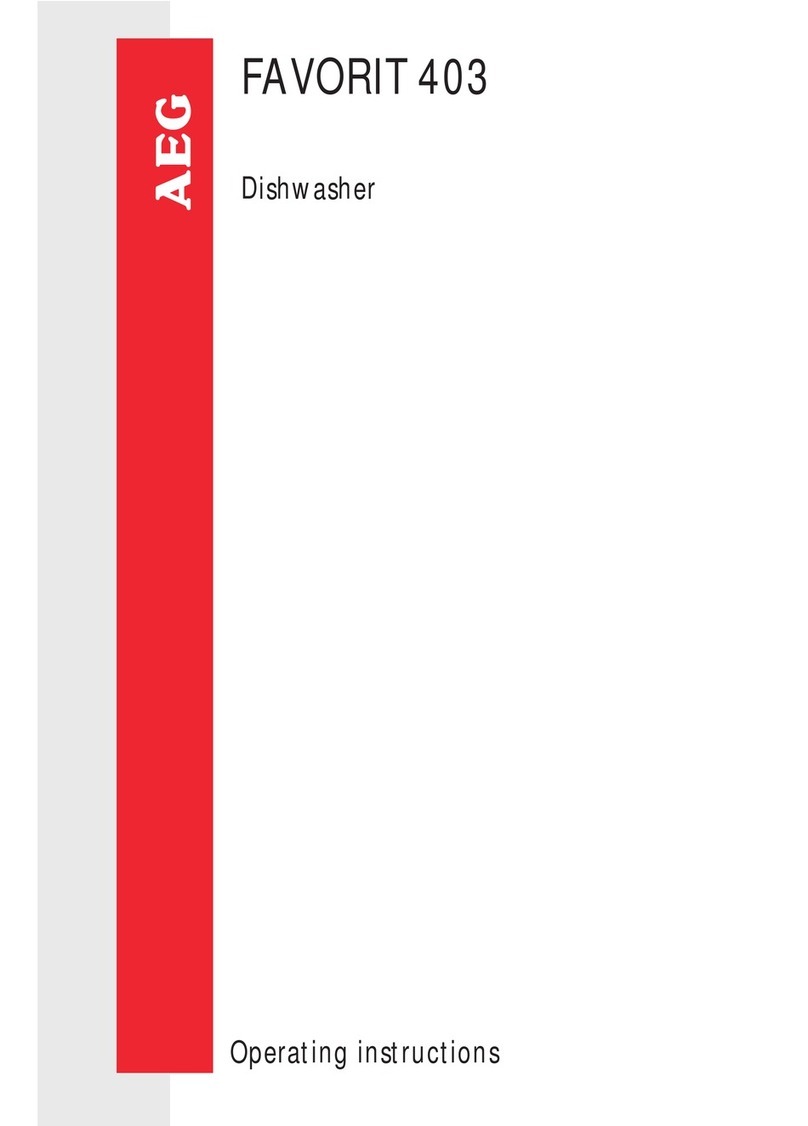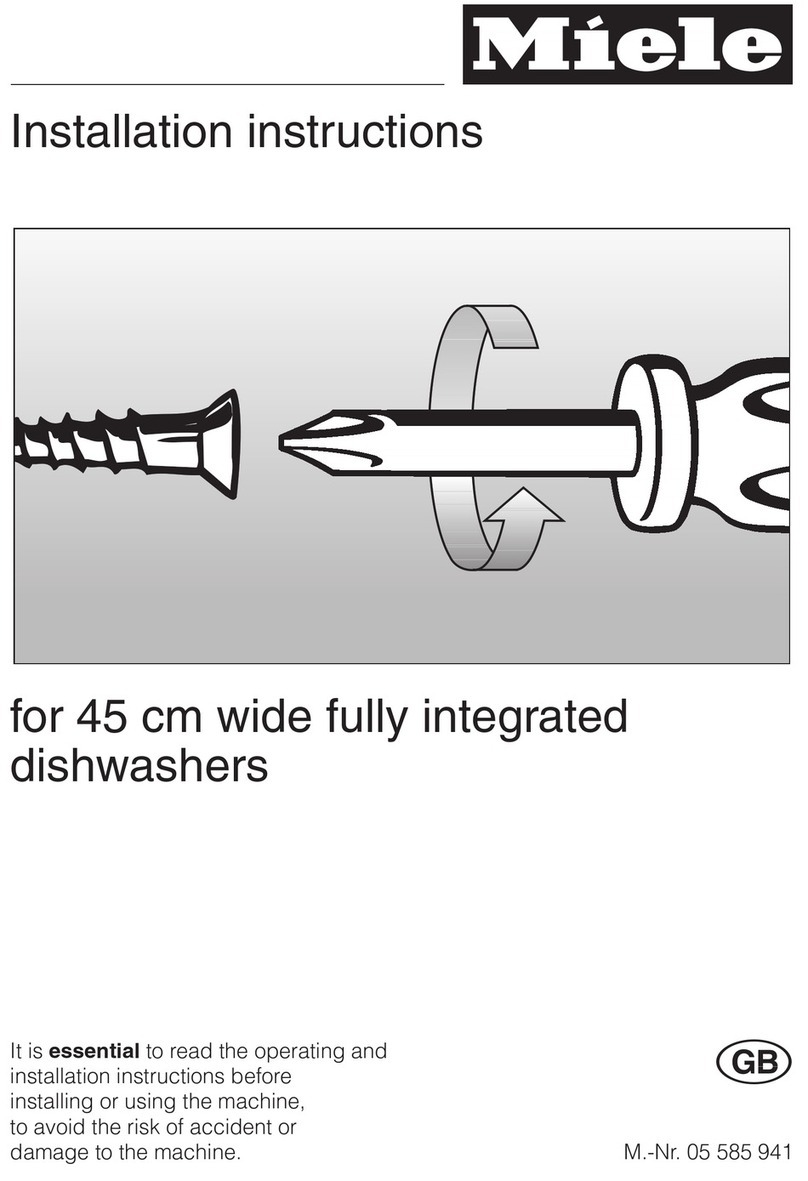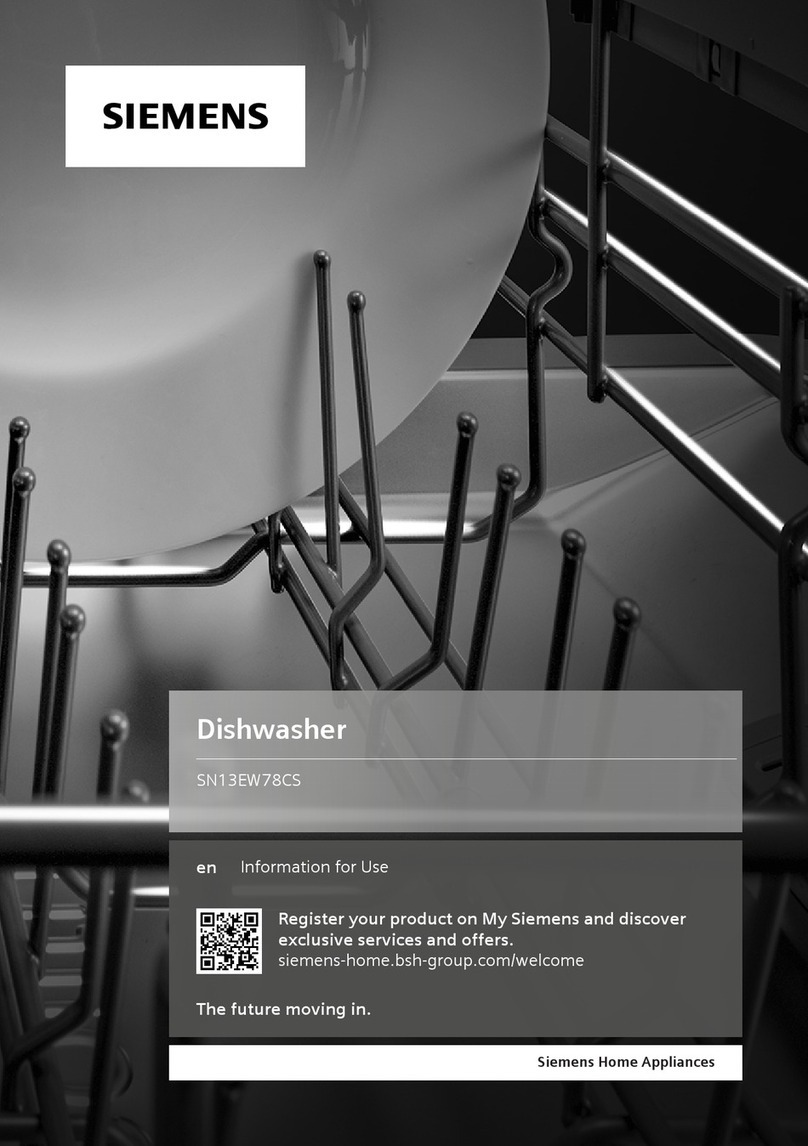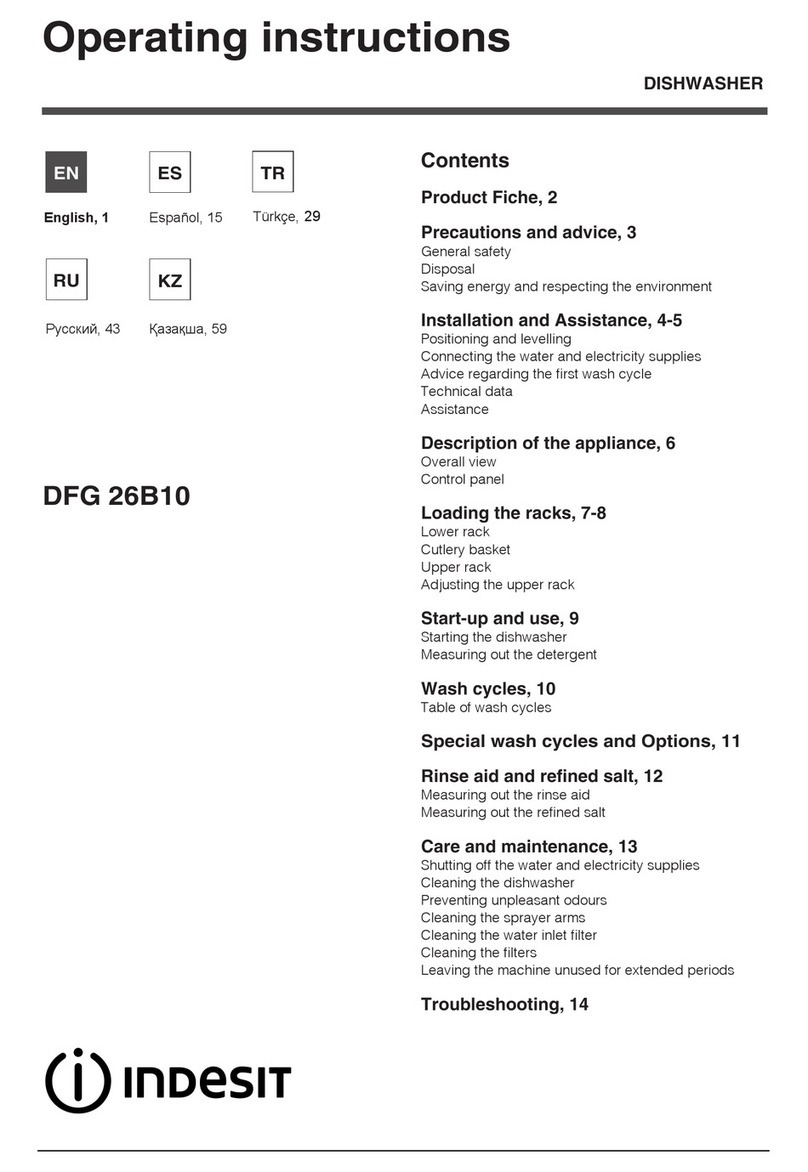Remedy
1. Replace fuse or reset breaker.
2. Repair or replace wire fasteners at
dishwasher junction box.
3. Replace timer.
4. Replacemotor/impellerassembly.
5. Replace latch assembly.
6. Replace latch assembly.
7. Replace selector switch.
1. Replace motor assembly.
2. Rotate motor impeller.
1. Check voltage.
2. Replacemotor/impellerassembly.
3. Clean and clear blockage.
1. Replace heater element.
2. Replace timer.
3. Repair or replace.
4. Replacethermostat.
1. Replacedispenser.
2. Replace timer.
3. Repair or replace.
4. Replacedispenser.
5. Replacedispenser.
1. Clearrestrictions.
2. Replace timer.
3. Replace pump.
4. Check for blockage, clear.
5. Replace windings.
1. Turn water supply on.
2. Replace water inlet fill valve.
3. Disassemble and clean screen.
4. Repair or replace.
5. Replace timer.
6. Repair or replace.
7. Clean float.
1. Replace timer.
2. Repair or replace timer.
3. Repair or adjust.
4. Replace or adjust position of
thermostat.
1. Repair to proper
32-inch minimum
height.
2. Install air gap at counter top.
1. Instructcustomer/user.
2. Instructcustomer/user.
3. Instruct customer/user on proper
loading of dishes.
4. Incomingwatertemperatureof120°F
is required to properly dissolve
dishwashingdetergents.
Trouble Shooting TipsExplodedView ofWash System
Tub and Door Seal
The door seal is pressed into the tub channel for
aninterference fit.Center thegasket (markedon
back) at the tub top center and press in place
Product Specifications
Electrical
Rating .................................. 120 Volts, 60Hz
Separate Circuit..15 amp min.- 20 amp max.
Motor (Amps) ........................................... 1.1
Heater Wattage ....................................... 900
Total Amps (load rated) .........................10.0
TempBoost (some models) .....122°F (50°C)
Heated Wash/Heated Rinse
Hi-Limit Thermostat .................200°F (93°C)
Water Supply
Suggested minimum incoming water
temperature ..............................120°F (49°C)
Pressure (PSI) min./max. ...................20/120
Connection (NPT)......................................3/8"
Consumption (Normal Cycle) ........................
......... 6.0 U.S. gal., 5.0 Imp. gal., 22.7 liters
Water valve flow rate (U.S. GPM) .......... .83
Water recirculation rate (U.S. GPM)..............
.................................................... approx. 12
Water fill time.....................................87 sec.
Detergent and Rinse Aid Dispenser
The detergent and rinse aid dispenser is a one
piece component consisting of a molded
detergent cup and a built-in rinse aid dispenser.
The detergent cup has a spring loaded cover
and the rinse aid dispenser has a removable
cover.
Liquid rinse aid is added to the dispenser up to
the fill line indicator. The amount of rinse aid
released can be adjusted by turning the arrow
indicator from one, being the least amount, to
four, being the greatest amount.
To replace dispenser:
• shut off electricity to dishwasher,
• remove outer door panel assembly,
• disconnect wiring to the actuator,
• remove the six screws,
• remove the dispenser,
• replace and reinstall screws,
• rewire actuator.
Standard Dry Air Flow
Whenthecontrol advancestothe “dry”portion of
the cycle, a linear actuator retracts a valve,
which opens a vent path through the console
into the kitchen. The heated, moist air leaving
thedishwasher throughthe consoleventcauses
drierair to bedrawn intotheunit bywayof intake
Check the Following
1. Fuse (blown or tripped).
2. 120 VAC supply wiring connection
faulty.
3. Timer (contacts open or defective)
4. Motor(inoperative).
5. Door switch (open contacts).
6. Door latch not making contact with
door switch.
7. Selector switch (open contacts).
1. Motor (bad bearings or locked
rotor).
2. Motor stuck due to prolonged
non-use.
1. Impropervoltage.
2. Motor windings shorted.
3. Glass or foreign items in pump.
1. Heater element (open).
2. Timerdefective.
3. Wiring or terminal defective.
4. Hi-limitthermostat defective.
1. Latch mechanism defective.
2. Timer contact defective.
3. Wiring or terminal defective.
4. Broken spring(s).
5. Defectiveactuator.
1. Drainrestricted.
2. Timer contact defective.
3. Defective drain pump.
4. Blocked impeller.
5. Open windings.
1. Water supply turned off.
2. Defective water inlet fill valve.
3. Check fill valve screen for
obstructions.
4. Defective float switch.
5. Timer contact defective.
6. Wiring defective.
7. Float stuck in “UP” position.
1. Timer motor (stalled or open.)
2. Check timer for power to timer
motor.
3. Timer shaft binding to or knob
interference with escutcheon.
4. TempBoostthermostat defective.
1. Drain hose (high) loop too low.
2. Drain line connected to a floor drain
not vented.
1. Detergent allowed to stand too long
in dispenser.
2. Dispenser wet when detergent was
added.
3. Detergent cover held closed or
blocked by large dishes.
4. Improper incoming water
temperature to properly dissolve
detergent.
5. See "Detergent cover will not
open."
Always disconnect the dishwasher from the electrical power source before adjusting or
replacing components.
Personal Injury Hazard
900 Watt Heater
Refer to the cycle chart on the reverse side to
determinewhen theheater ison duringthe wash
cycle. The heater cycles ON and OFF for brief
periods during the drying cycle.
Voltage checks of the heater should be made
with the timer set in the main wash.
of the drain pump. The drain hose is attached by
a worm gear clamp to the discharge end of the
drain pump.
The drain hose must have a loop at a
minimum
height of 32 inches
in order to insure proper
drainage.
The main pump can easily be removed by
disconnecting the upper spray arm supply tube
hose,thedrain pump connector hose, the wiring
harness connections made at the circulation
motorandrotatingthefoursumpretainerstoward
the middle of the sump.
Pump Assembly
The pump assembly is driven by a synchronous
motor. Rotation is in the counterclockwise
directionat 3600RPM.The motordrives a pump
which supplies 100 percent filtered water at a
rate to approximately 12 GPM to one spray arm
atatime.The sprayarm’soperationisalternated
by small “pauses” of the motor during the wash
cycle.
Draining is accomplished by using a small
separate synchronous drain pump mounted to
thesideofthesump.Thedrainpumpisconnected
to the main pump by a small rubber hose. The
draincheck valveis located atthe dischargeend
Symptom
Dishwasher will not operate when
turned on (wait at least 90 seconds).
Motor hums but will not start or run.
Motor trips out on internal thermal
overloadprotector.
Dishwasher runs but will not heat.
Detergent cover will not latch or
open.
Dishwasher will not pump out.
Dishwasher will not fill with water.
Timer does not advance.
Dishwasher water siphons out.
Detergent left in dispenser.
withoutstretchingor bunching.Thegaskettakes
a short turn at the bottom of the tub channel
before ending at the channel end wall.
Tub
Interior
Mounting
Rib
Gasket Cross Section
Short Turn
011129
vents located at the bottom of the door. The
water on the dishes is evaporated into drier air
and the venting process continues. The heating
element is turned ON and OFF during the entire
drying cycle.
Nozzle
Funnel
Nut
Funnel Base
Center Spray Arm
Lower Spray Arm
Delivery Tube
Connector Hose and Clamps
Sump
Water Valve
Water Inlet Tube
Check Ball
Circulation Motor
Assembly
Motor Bracket
Incoming Water Supply
Drain Hose
(32" minimum
height)
Spray Arm
Support
Glass Trap
Heating
Element
Filter
Soil Director
Volute Cover
Drain Motor
Sump Retainers (4)
